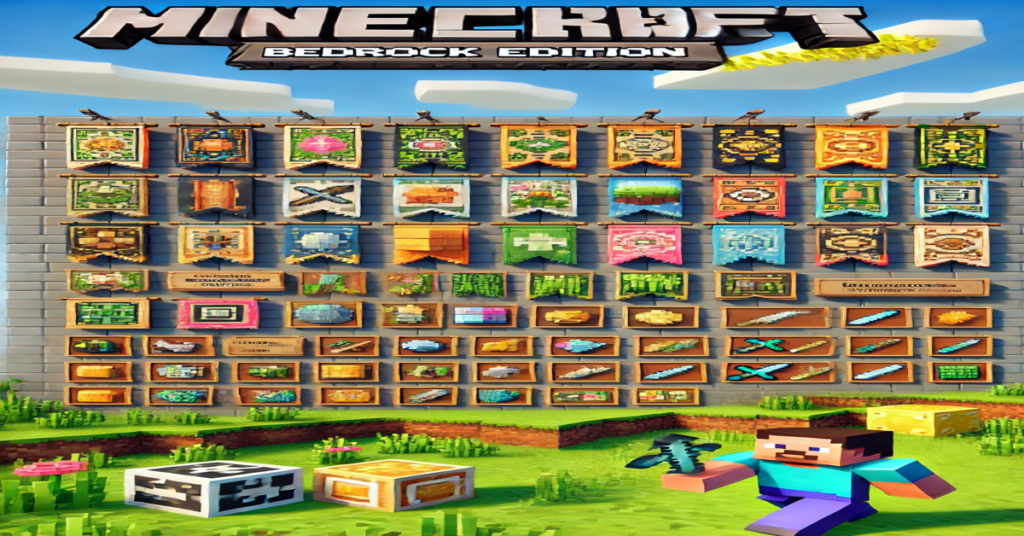Minecraft: Bedrock Edition, launched in 2011, introduced game elements that went beyond just crafting and exploration. Among these, game icons and banners have played a significant role in shaping the overall user experience. This article dives into the evolution, customization, and utility of these visual elements, providing a comprehensive understanding of how they enhance gameplay.
The Evolution of Game Icons in Minecraft: Bedrock Edition
Game icons in Minecraft: Bedrock Edition represent the various items, blocks, and tools players interact with. Initially, these icons were simple and functional, reflecting the minimalist aesthetics of the game. The 2011 version introduced the classic grass block icon, which became a symbol of the Minecraft brand. Over the years, these icons have undergone refinements, becoming more detailed and visually appealing.
The evolution of game icons mirrors the updates in the game itself. For instance, with the introduction of new materials like the Netherite in later versions, the corresponding icons were updated to reflect the rarity and strength of these items. Additionally, custom texture packs have allowed players to modify these icons, adding a personal touch to their Minecraft experience.
Customizing Game Icons: Personalization Through Resource Packs
While Minecraft: Bedrock Edition does not allow for in-game customization of icons, resource packs provide a workaround. Players can download or create custom textures for game icons, giving the game a unique aesthetic. These texture packs can be found on platforms like MCPEDL and CurseForge, offering a wide range of styles—from photorealistic to cartoonish designs.
Players often use custom icons to enhance inventory management. For example, an icon pack might make key resources like diamonds or obsidian stand out, helping players identify important items quickly. The ability to tweak these visual elements ensures that even a long-term player can keep their game fresh and engaging.
Banners in Minecraft: Bedrock Edition
Introduced later in the Bedrock Edition, banners quickly became one of the most popular features for customization. A banner is a tall block that can be decorated with various patterns, colors, and symbols. Crafted using six blocks of wool and a stick, banners serve as decorative elements, flags, or even functional markers within the game.
Players use looms to add patterns to their banners, layering up to six designs at once. The process allows for immense creativity, as each banner can be customized with 38 different patterns and 16 base colors. This system has given rise to a vibrant community where players share their designs, from simple geometric shapes to intricate recreations of famous logos.
Strategic Uses of Banners in Minecraft
Beyond their decorative use, banners serve strategic purposes in Minecraft’s multiplayer worlds. In territory-based games, banners are used to mark faction boundaries, allowing players to claim land and display their allegiance. In larger Minecraft worlds, banners act as navigation aids, helping players orient themselves by marking key locations such as bases or resources.
Another interesting application is using banners as map markers. Once a banner is placed in the world, it can be displayed on the player’s map, providing an easy reference point for navigation. This functionality is especially useful in survival modes, where finding your way back to a base or mine is crucial.
The Role of Banners in Storytelling
Minecraft: Bedrock Edition players have used banners to push creative boundaries, integrating them into gameplay mechanics and adventure maps. Banners are sometimes used in puzzle-based maps, where players must arrange specific banner patterns to unlock doors or progress in the storyline. This innovative use of banners showcases the versatility of these visual tools, enhancing both gameplay and storytelling.
Icon and Banner Customization in Different Versions
Although Minecraft: Bedrock Edition shares many similarities with Java Edition, there are some differences in how icons and banners function. For example, Bedrock Edition allows banners to be placed on the ground as standalone decorations, a feature not present in Java Edition. Additionally, the loom interface in Bedrock is more user-friendly, designed for intuitive cross-platform play.
Game icons in Bedrock Edition are optimized for touch interfaces and mobile devices, ensuring that they are easily recognizable across different screen sizes. Meanwhile, banner crafting remains largely the same across both versions, although some patterns and colors may render differently due to platform-specific rendering capabilities.
Best Practices for Designing Icons and Banners
When designing custom icons and banners, players should prioritize consistency and clarity. Overly complex designs can be hard to discern, especially on smaller screens, so keeping things simple is essential. Additionally, choosing contrasting colors can make icons and banners more visible against different backgrounds. Resource packs can further refine the user interface by allowing players to modify textures, sounds, and visual effects.
For advanced banner designs, players often combine multiple banners to create pixel art or optical illusions within their worlds. These techniques elevate the creative possibilities within Minecraft, turning banners into more than just decorative elements—they become a medium for artistic expression.
Conclusion
Icons and banners in Minecraft: Bedrock Edition (2011) are more than just functional elements; they are integral to the game’s visual identity and player creativity. Over the years, these tools have evolved, giving players more control over the aesthetics of their game world. Whether through custom texture packs for icons or intricate banner designs, Minecraft continues to offer endless possibilities for personalization. As the game grows, so too will the creative ways players use icons and banners to shape their Minecraft experience.


